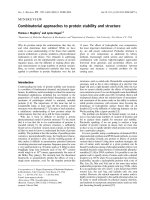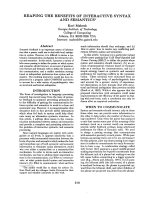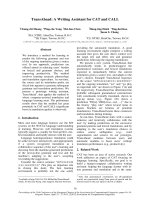Báo cáo khoa học: "Current critical care: up-to-date diagnosis and treatment" pdf
Bạn đang xem bản rút gọn của tài liệu. Xem và tải ngay bản đầy đủ của tài liệu tại đây (104.63 KB, 1 trang )
142
Critical Care April 2004 Vol 8 No 2 Radermacher
In general, textbooks in medicine that try to cover all areas of
a specialty are either huge volume editions, which therefore
serve as a reference whenever there is enough time for a
thorough search, or they present as pocket books that help
to quickly decide when peer assistance is not readily
available. Although Current Critical Care Diagnosis &
Treatment with its 945 pages certainly is somewhat
inconvenient for becoming a ‘pocket book’ in the narrower
sense of the word, its organization invites students, house
officers, fellows or those preparing examinations to have it on
their bookshelf and to look at it both when time is available as
well as when rapid decision-making is mandatory.
Admittedly, the book does not cover pediatric critical care
nor does it provide bedside technical procedure, nursing and
administrative chapters. Nevertheless, a number of crucial
chapters that are often neglected or at least under-
represented largely outweigh this inconvenience; for
example, those chapters on the philosophy of critical care,
pharmacokinetics, anesthesia and analgesia, patient
transport, ethical considerations, psychiatric problems and
the care of the elderly. In other words, a significant proportion
is dedicated to subjects for which research data are often
scarce but which make up for steadily growing problems in
the management of the critically ill.
The presentation of the book has three major highlighting
factors. First, after dealing with fundamentals of critical care
medicine as a whole, the book addresses both surgical and
medical — where possible directly succeeding each other,
such as the chapters on neurologic diseases and
neurosurgical critical care — and thereafter discusses
pathophysiologic aspects on organ-specific or disease-
specific approaches. Furthermore, Current Critical Care
Diagnosis & Treatment comprises numerous convincing and
instructive tables both on clinical and laboratory findings as
well as on therapeutic and dosing guidelines — an ideal
source both for those looking for quick information and for
those searching for background knowledge. Finally, I
particularly like the ‘Essentials of diagnosis’ that introduce the
individual chapters, important guidelines for the clinician
training in intensive care medicine.
Are there any items or ideas that I missed? Unfortunately,
yes. I only found carbon monoxide intoxications in the Burns
chapter (by the way, nowhere in the index!), and neither are
high-altitude disorders or diving emergencies dealt with in
the Environmental Injuries chapter nor do the mentioned
iatrogenic problems refer to gas embolism. Being a
‘European intensivist’, I also missed the issues ‘inhaled
prostacyclin’ and ‘transpulmonary thermodilution’ as well as
‘pulse contour analysis’ in the respective chapters on
Cardiothoracic Surgery, Respiratory Failure and Intensive
Care Monitoring.
As a whole, Current Critical Care Diagnosis & Treatment is
thus not only one additional single source reference textbook
of critical care, but it is worthwhile reading thanks to the
good chapters already highlighted. Hopefully, the lacking
issues will be covered in a subsequent edition.
Competing interests
None declared.
Book report
Current critical care: up-to-date diagnosis and treatment
Peter Radermacher
Professor of Anesthesiology and Critical Care, Sektion Anästhesiologische Pathophysiologie und
Verfahrensentwicklung, Universitätsklinikum, Ulm, Germany
Correspondence: Peter Radermacher,
Published online: 24 September 2003
Critical Care 2004, 8:142 (DOI 10.1186/cc2371)
This article is online at />© 2004 BioMed Central Ltd (Print ISSN 1364-8535; Online ISSN 1466-609X)
Keywords: medical intensive care, surgical intensive care, textbook
Bongard FS, Sue DY (Eds): Current Critical Care Diagnosis & Treatment, 2nd edition. New York:
Lange Medical Books/McGraw-Hill; 2002. 945 pp. ISBN 0-8385-1454-5









